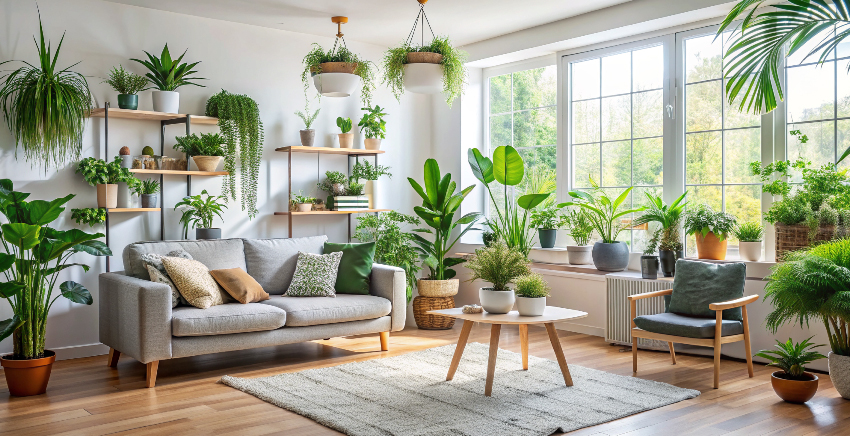In a world where most of our time is now screen time, the innate connection with nature that is engrained in us often feels distant. But what if the serenity of the forest and the tranquility of a flowing stream could be brought into our homes? This is the purpose of biophilic interior design—a design movement that seeks to reunite humans with the natural world, offering a refuge of peace and health and freeing us from the shackles of artificially coloured screens.
What is Biophilic Interior Design?
Biophilic design embraces the idea that humans have an inherent connection to nature. The term “biophilia” literally means the “love of life or nature,” and this concept was introduced by Stephen Kellert and Edward O. Wilson in the early 2000s. It focuses on integrating natural elements like light, plants, water, and organic materials into our living spaces. This trend isn’t mere aesthetic appeal; it’s about creating environments that support well-being, mental health, and productivity.
Why is Biophilic Interior Design Important Today?
According to studies, we spend almost 90% of our time indoors, which is a lot of time away from natural light. This disconnection can affect our mental health, productivity, and even our immune systems. Biophilic interior design remedies this by bringing natural elements into our homes, creating spaces that nurture our emotional and mental well-being. In the new age, this has become an unavoidable necessity for those who desire the calm that nature provides.
The Benefits of Biophilic Design
- Improved Mesntal Health
- Nature has long been associated with calmness and tranquility. Biophilic architecture taps into these benefits by creating spaces that reduce stress and anxiety. Studies show that the presence of natural elements indoors can reduce cortisol levels and enhance mood, contributing to a healthy indoor environment .
- Enhanced Air Quality
- Indoor plants serve as natural air purifiers. Species like snake plants, ferns, and peace lilies can remove toxins from the air, promoting a cleaner, fresher atmosphere. This is particularly important in urban settings where air pollution is a concern.
- Increased Productivity
- A workspace designed with biophilic home decor can improve focus, creativity, and overall productivity. Natural light, greenery, and open spaces are shown to boost cognitive function, making them ideal for home offices and creative workspaces.
How to Incorporate Biophilic Design into Your Home
You don’t need a complete renovation to embrace the biophilic interior design trend. Here are some simple ways to introduce nature into your living space:
- Maximize Natural Light
- Position furniture and use light curtains to flood your rooms with sunlight as much as possible. Natural light not only boosts mood but also improves overall health by supplying much-needed Vitamin D.
- Bring in the Greenery
- Incorporate indoor plants for good health, such as spider plants, fiddle leaf figs, or even small succulents. These plants not only purify the air but also create a sense of calm and relaxation.
- Use Natural Materials
- Go for furniture made from wood or bamboo to create an eco-friendly interior design. Materials like cork and stone also add a tactile, earthy feel to your home, aligning with nature-inspired interiors .
- Embrace Water Features
- The sound of rain or flowing water has been proven to enhance relaxation and calm. Simple additions like tabletop fountains or fish tanks can introduce this peaceful element into your home.
- Incorporate Organic Shapes
- Steer away from straight lines and sharp angles. Instead, look for organic shapes and soft curves that mimic the natural world. This can be reflected in furniture, decor, or even architectural features like arched doorways
The Future of Biophilic Design
As the world becomes increasingly urbanized, the need for sustainable and green interior design solutions is only growing. The future of biophilic architecture will likely see a deeper integration of nature into everyday spaces, from homes to office buildings. As designers continue to innovate, the lines between the built environment and the natural world will blur, making homes not just places to live but sanctuaries that promote health and well-being.
Why Amanora Park Town is the Best Example of Biophilic Living
At Amanora Park Town, biophilic and sustainable living come together seamlessly. Located in Hadapsar, this innovative property blends cutting-edge architecture with the principles of biophilic interior design to offer its residents a peaceful, health-focused lifestyle. Amanora Crown Towers are designed with natural light, greenery, and organic materials, making it the ideal property in Hadapsar for those seeking a connection with nature.
Biophilic interior design is about a necessary shift toward a more harmonious way of living. By embracing nature within our homes, we can enhance our health, happiness, and connection to the world around us. And when it comes to choosing a home that embodies these values, Amanora Park Town is truly in a league of its own.





